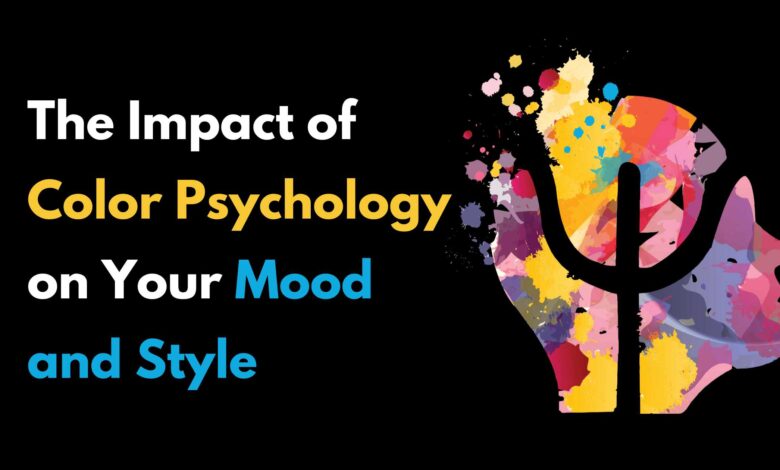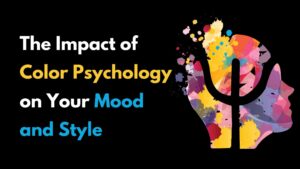Amazing Impacts of Color Psychology on Your Mood and Style


Color psychology is the study of the influence of colors on human behavior, emotions, and perceptions. The colors around us have a huge impact on our mood and life as a whole. This concept extends to all aspects of life, including interior design, fashion, and branding.
Understanding the psychological impact of color can help us make more informed choices in our nature and environment, ultimately leading to better emotional and expression. personal. This article explores how color psychology influences shape and form, showing how we can use color to our advantage.
Table of Contents
Learn Color Psychology
The psychology of color shows that different colors can produce different emotional responses. This understanding is based on cultural connections, personal experiences, and even biological responses.
For example, warm colors like red, orange, and yellow are associated with energy, warmth, and happiness, while cool colors like blue, green, and purple are associated with to calmness, relaxation and tranquility. By understanding this relationship, we can use the power of color to positively influence our mood and appearance.
The Influence of Color on Character
Colors have a direct impact on our emotions and can strongly influence our mood. Here are some common links and effects of different colors:
Red: Red is a powerful color, associated with passion, strength, and power. It stimulates the senses and increases the heart rate, which is good for environments that require activity and excitement. However, too much red can cause feelings of anger or stress.
Blue: Blue is known for its calming effects. They are often used in rooms designed for relaxation and tranquility, such as bedrooms or spaces. Blue can also increase the sense of trust and reliability, making it a popular choice in corporate environments.
Yellow: Yellow is associated with happiness, ambition, and creativity. You can improve your mood and create a feeling of warmth and happiness. However, sometimes too much yellow can cause anxiety and anger.
Green: Green symbolizes nature, balance and renewal. It is relaxing and is often used in rooms that focus on relaxation and rejuvenation. Green will improve concentration and be used in workplaces.
Purple: Purple is associated with luxury, creativity, and spirituality. It can evoke a sense of intrigue and mystery. Light purple colors, such as lavender, are very calming, while dark colors, such as purple, are more stimulating.
Orange: Orange combines the energy of red with the excitement of yellow. It is associated with enthusiasm, creativity and warmth. The color orange stimulates social interaction and is used in social areas such as living rooms and dining rooms.
Pink: Pink is often associated with love, romance, and peace. It can create a kind and peaceful environment. Light pink is very calming, bright pink is energizing.
The Influence of Color on Character
In the world of fashion, color plays an important role in how we express ourselves and others. The colors we choose can influence our mood, reflect our personality, and influence our level of confidence.
Here are some of the effects of color on personal appearance:
Boosts Confidence: Wearing bold and bright colors like red or royal blue can make you feel more confident and confident. These colors attract attention and can show strength and courage. Calm and peaceful: Cool colors like blue and green can create a sense of calm and serenity. It’s perfect for situations where you want a calm and relaxed look.
Creative Expression: Bright and contrasting colors like yellow, orange, purple can be used to show creativity and individuality. These colors can make your clothes stand out and give off a cheerful and imaginative look.
Elegance and simplicity: Neutral colors like black, white, gray, and beige are associated with elegance and sophistication. Versatile and timeless, these colors are perfect for formal and professional settings.
Feel better: The colors you wear influence your mood throughout the day. For example, wearing yellow or pink clothes can make you feel better and happier, while wearing blue clothes can help you feel better and more focused.
Job Application
To use the power of color psychology in your everyday life, consider these practical applications:
Home Decor: Choose colors for your living room based on the look you want to create. For example, use calm blues and greens in bedrooms and bathrooms, and choose bright colors like red or orange in social areas like the kitchen and living room.
Clothing selection: Create an outfit in many colors to suit different situations and locations. Try different colors and see how they affect your mood and confidence levels.
Work environment: Strategic use of color in the workplace can increase productivity and focus. Include hints of green or blue to create a calm atmosphere, and add yellow or orange to stimulate creativity.
Also Read: 5 fitness tips to stay active without a workout
Conclusion
Color psychology is a deep understanding of how colors influence our moods and emotions. By understanding the emotional effects of different colors, we can make better choices in our personal and professional lives. Even through interior design, fashion, and everyday environments, the use of color can improve our quality of life, self-expression, and quality of life.




